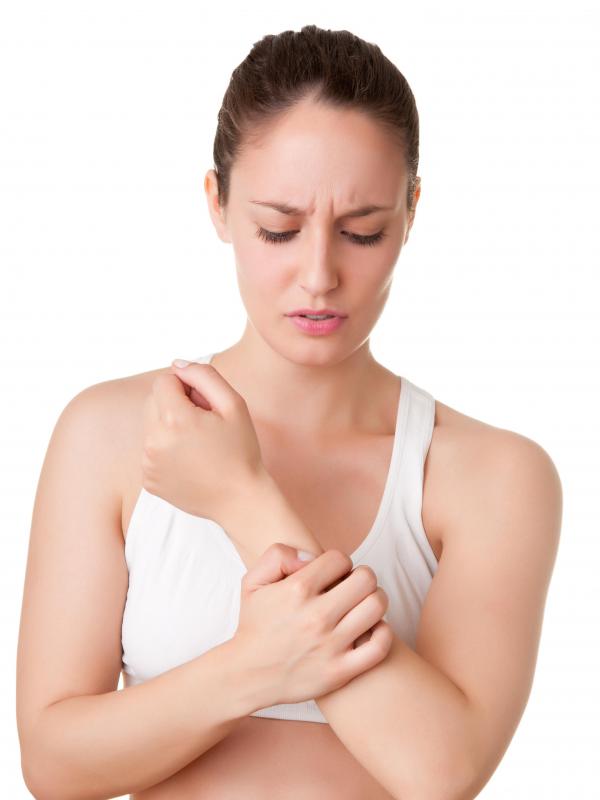At WiseGEEK, we're committed to delivering accurate, trustworthy information. Our expert-authored content is rigorously fact-checked and sourced from credible authorities. Discover how we uphold the highest standards in providing you with reliable knowledge.
What is a Forearm Band?
A forearm band is a type of orthotic device used to help mitigate the symptoms associated with tennis elbow, tendinitis, and other similar conditions. Wearing one typically eases strain on ligaments, tendons, and muscles between the wrist and elbow, and can prevent pain and damage due to swelling and overuse. The most common type of forearm band is simply a padded nylon or Neoprene® strap with a Velcro® cinch.
Generally, use of a forearm band is an initial, conservative step in the treatment of forearm pain. This pain is commonly diagnosed as being symptomatic of tendon-related conditions like tennis elbow, also known as lateral epicondylitis. Such injuries are characterized by stiffness and pain in the elbow and on down the wrist, both at rest and exacerbated during certain movements.

Tennis elbow, as its name implies, is a common condition among players of the game due to the particular biomechanical stresses inherent in a tennis swing. It is hardly limited to this group however, and can occur as a repetitive stress injury among a wide variety of people who do a lot of work with their arms. Whereas tennis elbow is the name given to pain on the outside of the elbow, pain on the inside is referred to as golfer's elbow, which is otherwise a similar condition. Either injury can also flare up following a distinct single trauma, though this is less common.
The normal prescriptive use of a forearm band calls for wearing it during the waking hours for a period of several weeks. This is coupled with regular icing, a conscious effort to rest the afflicted arm as much as possible, and regular doses of pain relievers and anti-inflammatory drugs. More aggressive treatments include ultrasound and cortisone injections. Only in severe cases is surgery needed to repair damage.
A forearm band limits pain by isolating and compressing injured tendons in the elbow, and restricting their movement. This in turn gives the damaged tissue a chance to repair itself without the risk of constant re-injury. The band is properly worn a short distance below the actual source of pain in the arm, and not directly over it. Physical therapy is usually recommended to help strengthen the elbow area after it is judged to have healed sufficiently.
Though basic forearm straps are little more than padded Velcro® bands, there are added features that more expensive models may have. These include gel inserts that can be heated or frozen to aid in healing, and pneumatic bladders that can be inflated to increase compression, among other things. These are certainly luxury options, however, and ultimately not required for a forearm band to be effective if it is worn correctly.
AS FEATURED ON:
AS FEATURED ON:











Discussion Comments
I used to play a lot of tennis when I was in my twenties, but I gave it up years ago. A few months ago, my wife decided she wanted to take up the sport, so I agreed to be her opponent. We played about three times and I started feeling a lot of pain in my wrist and forearm.
My neighbor happened to be a doctor, so he agreed to look at it informally. He told me it looked like tennis elbow at first, but then he decided it was more of a forearm strain. He recommended going to a medical supply store and getting a therapeutic forearm band. It was a snug fit, but between ice baths at night and the forearm support band during the day, I got better enough to go back out to the tennis court.
I had a bad fall off a bridge many years ago and I landed directly on my wrist and forearm. I didn't seek medical treatment at the time, but I could tell the muscles and tendons in my arm were badly strained. A few years later, I got a job in a local deli, where part of my job involved slicing meat on a manual meatslicing machine. I had to move that same injured arm back and forth repeatedly. One day my entire arm felt like it was on fire, and I had very little grip strength.
The doctor examined my arm and said I had severe tendinitis. He told me to take over-the-counter anti-inflammatory medications for the pain and swelling. Then he wrapped an elastic forearm support band about two inches down from my elbow. He said the band would give my arm muscles something to work against, so they wouldn't get inflamed again. He ordered complete rest of that arm for two weeks, so my manager had to take over the meat slicing duties for a while.
Post your comments